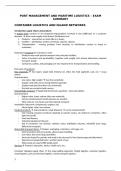Samenvatting
Samenvatting Minor Port Management and Maritime Logistics - verplichte literatuur + hoorcolleges
- Instelling
- Erasmus Universiteit Rotterdam (EUR)
Dit document bevat een samenvatting van alle verplichte literatuur en alle hoorcolleges.
[Meer zien]




